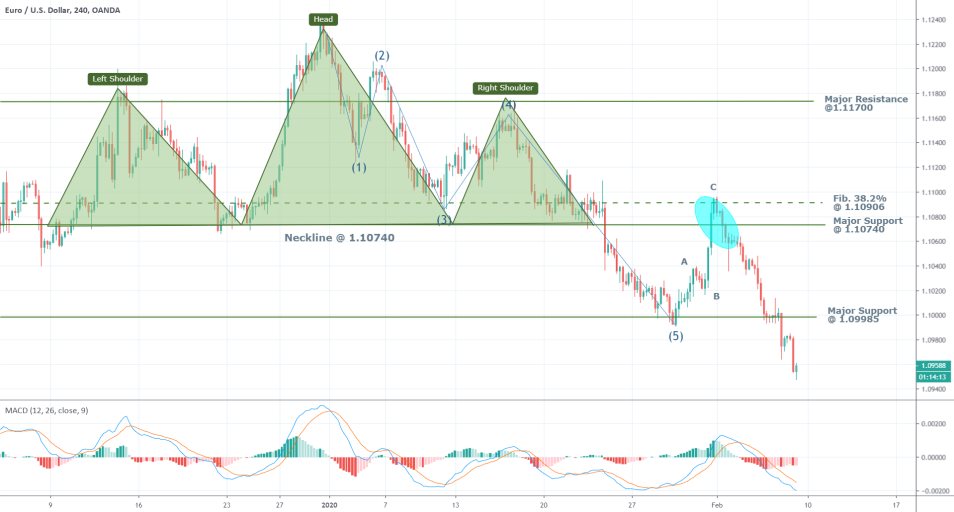
The President of the European Central Bank Christine Lagarde spoke in from of the Committee on Economic and Monetary Affairs of the European Parliament on Thursday.
The focal point of her speech was focused on the appropriateness of the European monetary policy, and the currently undergoing process of its re-evaluation.
Lagarde presented a mostly optimistic outlook on the current state of affairs in the European economy, which is more or less the only welcoming news that European investors got from the meeting.
However, she acknowledged for the second time in the last several months the fact that the current structure of the monetary policy might be outdated or at the very least partially ineffective, which is why the euro fall shortly after the conclusion of her statement.
“More than 16 years have passed since the ECB last reviewed its strategy. And as we discussed in December, since 2003, the world economy has undergone profound structural changes that have transformed the environment in which monetary policy operates.”
Despite the moderate growth that was recorded in Europe in the last fiscal quarter and the resilience that the broader economy has demonstrated in spite of subdued global demand, investors fear that if the ECB determines that its monetary policy needs to be revised, this might bring about a new type of uncertainty on the market.
Such a revision would not only take time to be concluded, but it would also have to be conducted in the current unstable geopolitical landscape globally and fragile world economy.
That is why some experts have questioned whether now is the best time to conduct such a review, seeing as those structural and profound changes that were noted by Lagarde might not be entirely discounted by Eurozone's economy yet.
In other words, the ECB is right to question the applicability of the current monetary policy. However, the economic conditions might not offer a clear and concise picture of the policy's impact on the underlying economic processes.
That is why the euro weakened marginally against other currencies during Thursday's trading session. The undergoing strengthening of the dollar further underpinned this tumble.
Meanwhile, the EURUSD extended its bearish downswing, and the price of the pair is currently trading around 1.09680 – a level that was last tested in Late-October 2019.
The development of this bearish correction was first examined in our weekly expectations update from Monday. There you can read more about the relation of Elliott Wave Theory to the current price action.
Overall, the bearish sentiment is very strong at the current moment, and the MACD confirms the strengthening momentum in the price action.

Trendsharks Premium
Gold is undergoing a correction, as investors take profits to offset losses from falling stock prices, impacting their margins. However, we anticipate a renewed wave of [...]
The Swiss stock market index is mirroring its global counterparts, such as Germany 40 and US100, experiencing a sharp decline following the announcement of new [...]
We’re analyzing the weekly chart to grasp the broader market trend. Over the past three years, the US30 index has surged by 17,000 points, often resembling a nearly straight [...]
Over the past week, the DAX has experienced a sharp decline, plunging by an astonishing 3,400 points. This downward movement is not isolated, as its international counterparts, such as the UK100 and US100, are also facing significant [...]
EURUSD recently formed a double top at 1.0930, signaling a potential trend reversal, and has since begun a correction. After a 600-pip rally since early March, a pullback at this stage is both expected and healthy. Given these conditions, we are placing a [...]
Since early March, EURJPY has surged nearly 1,000 pips, providing us with several excellent trading opportunities. However, as the rally matures, many early buyers are beginning to take profits, leading to a noticeable slowdown in the uptrend. On Friday, the pair formed a [...]
The AUDJPY currency pair continues to be dominated by bullish momentum, as multiple golden cross patterns reaffirm the strength of the ongoing uptrend. Despite this, we are witnessing a much-needed [...]
The EURAUD currency pair appears to be undergoing a trend reversal, signaling a potential shift in market direction. A notable technical development is the formation of a Death Cross on the chart, a widely recognized bearish indicator that typically suggests a [...]
After securing an impressive 200-pip profit last week, the EURJPY currency pair is now undergoing a southward correction, retracing some of its recent gains. Despite this temporary pullback, the Golden Cross remains intact, reinforcing our view that the overall trend continues to be [...]
The appearance of a Golden Cross in Silver strengthens our analysis that the metal is currently in a strong uptrend, indicating further bullish momentum in the market. This technical pattern, where the short-term moving average crosses above the [...]
This trade presents a considerable level of risk and can be classified as an opportunistic move based on recent price action. The GBPUSD currency pair has experienced a substantial bullish rally, surging by nearly 500 pips in a strong upward movement. However, after this extended period of appreciation, the pair is showing signs of a potential [...]
The anticipated Death Cross on the SMI20 appears to be failing as price finds strong support at the 23% Fibonacci retracement level. After testing this area, the index has shown bullish strength, printing several large green candles, signaling an increase in [...]
A Golden Cross has just appeared on the USDJPY chart, signaling a potential bullish move. This technical pattern occurs when the 20 period moving average crosses above the 60 period moving average, a widely recognized indication of increasing [...]
After 2 months of a down trend, we finally see some indications of price recovery for Oil. The golden cross, a historic buy signal, supports this [...]
For the past month, the German DAX40 has experienced a remarkable 10% surge, reflecting strong bullish momentum. Despite ongoing market volatility and frequent pullbacks, every dip continues to attract fresh buyers, reinforcing the [...]
Oil continues its downward trajectory, despite occasional pullbacks. The overall trend remains bearish, reinforced by multiple Death Cross patterns, a classic sell signal indicating further weakness. Adding to this bearish outlook, the critical [...]
Over the past few days, gold has experienced a sharp decline of more than $100. This downturn can be attributed in part to traders securing profits to manage their margins, which are under strain due to the significant drop in major indices. Currently, gold has fallen below the [...]
The NASDAQ 100 index is showing strong bullish momentum, as evidenced by the formation of a Golden Cross on the chart. This classic buy signal occurs when the short moving average crosses above the long term moving average, suggesting that upward momentum is [...]
The EURAUD currency pair has encountered a significant resistance level, failing to break above the critical 61% Fibonacci retracement level. This suggests that bullish momentum is weakening, reinforcing the case for a potential downward move. Given this technical setup, we favor entering a [...]
The UK100 is experiencing a remarkable rally! Over the past few weeks, the British stock market index has surged nearly 800 points. Each minor dip has attracted more buyers, fueling the bullish momentum. However, since last week, we’ve observed a slight [...]




















